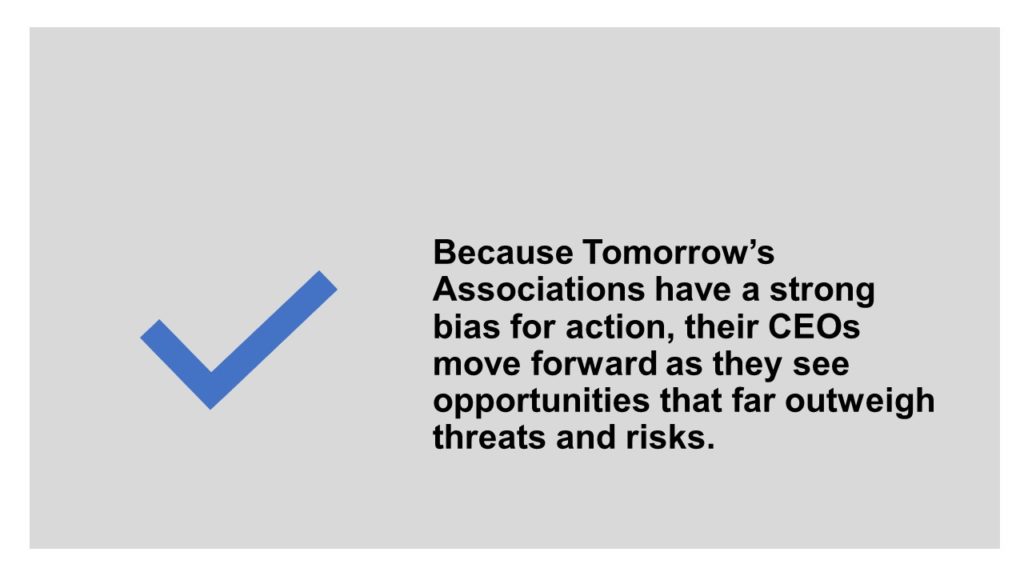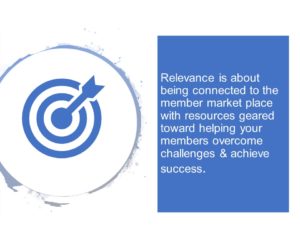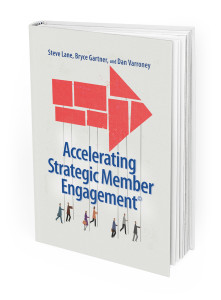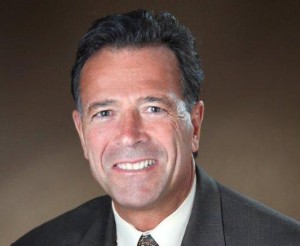
Breaking. Members Hire Tomorrow’s Associations because they have no other choice. Global uncertainty and technological advances are forcing Members to make more informed decisions on how to spend their precious time and money. Members expect their Associations to be nimble, future focused, and having the speed and foresight to help move an Industry forward. Organizations recognizing this shift are transforming from yesterday’s Associations to Tomorrow’s Associations.
Members hire Tomorrow’s Associations because they sit at the cutting edge of change and:
- In a time of political gridlock, they are perceived as increasing spheres of influence. They’re also transforming themselves into more potent and influential extensions of an Industry.
- Utilize market research to pinpoint challenges and build strategic opportunities to overcome those challenges. In doing so, they help create a more favorable climate to drive Industry growth.
- Relentlessly look for whatever comes next in their Industry.
- Seamlessly move from yesterday’s challenge toward tomorrow’s opportunity.
- See their organizations as the front line and last line of defense for an Industry.
 Using relevance as their foundation, these organizations conduct research and engage boards and members to identify and address the next set of Industry challenges. They also understand the Industry’s business model from product design to marketplace, and the staff teams approach everyday as an act of invention:
Using relevance as their foundation, these organizations conduct research and engage boards and members to identify and address the next set of Industry challenges. They also understand the Industry’s business model from product design to marketplace, and the staff teams approach everyday as an act of invention:
Helicopter Association International – Keeping the rotors turning is all that matters for HAI. Led by Matt Zucarro, an Industry veteran, and President & CEO, the Association relishes its role as the Industry’s advocate in chief. “We don’t let anything get past us” notes Zucarro as his experienced team is ready to address any market or regulatory obstacle that will prevent the rotors from turning. Simultaneously, they aggressively promote the economic value of the Industry in meetings with legislators and regulators in domestic and international markets. The Association remains closely connected to Industry trends through insightful research and direct Board engagement.
Since 2005, the Association transformed itself into a well-capitalized, forward looking, and fast moving extension of the Industry. Implementing a strong bias for Industry growth, HAI annually conducts the world’s largest helicopter exposition, the HAI Heli Expo Trade show which includes business networking and technical resources that address Member business challenges and opportunities. In addition to the Trade Show, the Association delivers resources geared toward helping Members address flight and operational safety with an Aircraft Risk Assessment Tool and a Safety Accreditation Program.
The Advocacy program is the first and last line of defense for the Industry. When the FAA (Federal Aviation Administration) grounded operators due to a technical revised interpretation of regulations, HAI and their members worked successfully to speed up and streamline the exemption process. In doing so, the Industry was able to get back to work.
While addressing today’s challenges, Zucarro and his team are helping to position the Industry for the future:
- “Autonomous flight is coming, technology is going to allow it, it’s a matter of public acceptance.” HAI is working with Federal Agencies and other Associations including the Association of Unmanned Vehicles (AUVSI) to help define the future through unmanned flight.
- Although workforce shortages plague the Helicopter Industry now, the HAI team is collaborating with the Industry to build the Industry’s workforce of the future. Concrete strategies are being developed through the Helicopter Foundation to promote careers and help lead more pilots and technicians to choose careers in the Industry.
The International Sign Association – Annual Strategic Planning with its Board and 3 Steering Committees plus ongoing market engagement keep the Association aligned with the present and the future. Insisting upon transparency, the ISA team shares progress reports with Board Members four times each year. This level of market research plus Industry focused surveys, keeps the Association connected to today’s and tomorrow’s “Up at Night” challenges.
Led by Lori Anderson, President & CEO, the organization delivers business value in measurable ways:
- The International Sign Expo – Business to business networking and emerging technologies.
- Actionable Industry Research – Quarterly economic reports, wages and benefits surveys, and research that identifies the economic impact of a sign.
- Local sign code guidance – Plus legal support to help the Industry achieve sign approval.
Starting in 2013, the workforce shortage topic continually appeared in ISA’s research. Since then, utilizing an innovative digital approach, the Association is working to help the Industry educate, attract, and retain workers. Through strategic partnerships and adding skilled staff, the Association created a platform to help assess and teach skills to current and prospective workers. Though this online learning platform candidates can earn up to 15 digital badges. The strategy, since 2015, has helped students achieve approximately 7,000 badges. The workforce program is continually evaluated and updated to support the Industry’s workforce needs.
ISA also leverages its “Sign Manufacturing Day” to create student awareness of the Industry. Starting with just 8 companies and 200 students, the program now has eighty four companies participating and 3,500 students. Lori Anderson notes that “these programs help companies recruit interns on the spot.”
Health Industry Distributors Association – Leading and convening all aspects of the Industry in a Healthcare Supply Chain Collaborative. CEOs from Distributor Companies gather at HIDA to utilize this cooperative platform, brainstorm, and develop strategic solutions that optimize supply chain efficiency. The organization also incorporates Manufacturers in its market focused efforts through the HIDA Educational Foundation.
The Association is also familiar with Industry’s products and business model. Understanding member pain points through direct engagement and market research, the organization evolves as market place challenges and opportunities change.
It’s current suite of products are designed to help members stay connected to what’s new or anticipated in their marketplace: Business Intelligence on Supply Chain Strategies, Telemedicine, Market Reports, & Segmented market reports.
Through Industry focused Advocacy:
- The Association is collaborating with federal agencies to provide help during an emergency event. This will help federal emergency responders engage the commercial healthcare supply chain during crisis by centralizing key attributes of commercial medical-surgical distribution centers in an online tool.
- Successfully had 120 products manufactured in China exempted from additional import tariffs.
Matthew J. Rowan, President & CEO leads the Association.
Transforming into one of tomorrow’s Associations is no small task. Each Industry or Profession is different and making big changes could take more time. Consider starting with actionable market research and collaborative board discussions. Doing so will help build a foundation that leads to the larger transformation. For example, Alison Bodor, President and CEO, American Frozen Food Institute is leading a longer term change. Along with her team, she continually utilizes market research to inform and guide strategic discussions around food safety and Frozen Food consumption with the Board and their members. One of the near term deliverables is a new research report by AFFI and the Food Marketing Institute (FMI) titled “The Power of Frozen.” The report examines consumption drivers, purchase drivers, channel drivers, opportunities for collaboration, and shares opportunities for how companies can drive continued growth in the Frozen Food category. Thoughtful approaches like AFFI’s plant the seeds of transformational change.
Members Hire Tomorrow’s Associations
 Tomorrow’s Associations including Helicopter Association International, Health Industry Distributors Association, International Sign Association, and other leading organizations including, Global Cold Chain Alliance, American Bakers Association, and the National Marine Manufacturers Association are all unapologetically getting it done for their Industries as they:
Tomorrow’s Associations including Helicopter Association International, Health Industry Distributors Association, International Sign Association, and other leading organizations including, Global Cold Chain Alliance, American Bakers Association, and the National Marine Manufacturers Association are all unapologetically getting it done for their Industries as they:
- Leverage actionable research to position Industries for new opportunities.
- Advance the innovative aspects of products to elected officials and consumers.
- Champion Industries and position them for Market Growth.
- Promote the economic impact of Industry products and services to domestic and international legislative and regulatory bodies.
- Cite how Industries increase employment and influence community quality of life, and in several cases, help to attract the next generation of workers.
Because Tomorrow’s Associations have a strong bias for action, their CEOs move forward as they see opportunities that far outweigh threats and risks. “Turn every threat into an opportunity. In order to do that you need to surround yourselves with the right talent. Take some risk in a period of uncertainty not avoid it” notes PWC’s CEO Bob Moritz. Yes, uncertainty should be an immediate call to action for yesterday’s Associations. Breaking. Members Hire Tomorrow’s Associations because they have no other choice.
To learn more about how your organization can become one of Tomorrow’s Associations click here.





















